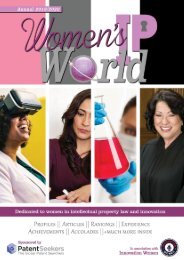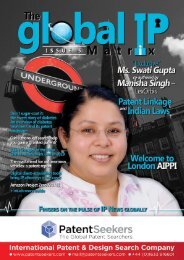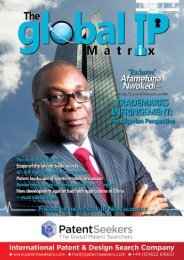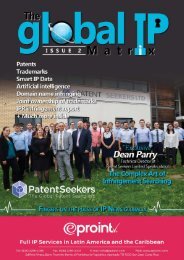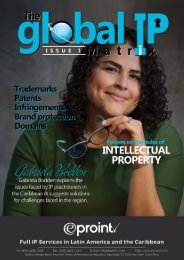Global IP Matrix - Issue 7
Dear readers, We sincerely hope that you are all in good health and keeping in good spirits during these undeniably uncertain times. We have all had to adapt to working out of our comfort zones, which I am sure has been very challenging at times for you all as it has been for us. However, we continue our quest to look to the future and deliver exclusive content to you, direct from thought leaders working at ground level in the IP industry from all over the world. Issue 7 of The Global IP Matrix magazine is packed with informative and exciting articles to keep you up to date and educated in what has been developing in the global IP industry during the past few months and into the future. We hope you enjoy reading our publication. We want to thank all our contributors for sharing their knowledge, opinions, and expertise in this new edition of the Global IP Matrix magazine. From all of us at The Global IP Matrix & Northon's Media, PR & Marketing Ltd
Dear readers,
We sincerely hope that you are all in good health and keeping in good spirits during these undeniably uncertain times. We have all had to adapt to working out of our comfort zones, which I am sure has been very challenging at times for you all as it has been for us.
However, we continue our quest to look to the future and deliver exclusive content to you, direct from thought leaders working at ground level in the IP industry from all over the world.
Issue 7 of The Global IP Matrix magazine is packed with informative and exciting articles to keep you up to date and educated in what has been developing in the global IP industry during the past few months and into the future. We hope you enjoy reading our publication.
We want to thank all our contributors for sharing their knowledge, opinions, and expertise in this new edition of the Global IP Matrix magazine.
From all of us at The Global IP Matrix & Northon's Media, PR & Marketing Ltd
Create successful ePaper yourself
Turn your PDF publications into a flip-book with our unique Google optimized e-Paper software.
Pharmaceutical
Extortion
Written by Vladimir Biriulin, Partner at Gorodissky & Partners
www.gorodissky.com
The topic of compulsory
licensing occasionally surfaces
on the Russian horizon.
The law (Article 1508 of the Civil Code)
provides that a trademark protected in
Russia based on its state registration or in
accordance with an international agreement
or used as a trademark, or a designation used
as a trademark but not registered as such in
Russia may be recognised as a well-known
trademark. However, it can only be recognised
from the date indicated in the application if
that trademark or that designation became
widely known among relevant consumers in
Russia as a result of its intensive use.
It is Not the Date of the
of the Application
All this, even though there are several
longstanding provisions in the Civil Code:
one allows the use of a patent without the
owner’s permission in the interest of defense
and security (Article 1360) (Russia has not
and hopefully will not come to that situation).
Additionally, Article 1362(1),
allows filing a claim to court
for a compulsory license if
the invention is not used
within four years. Again,
this provision is not used
frequently by interested
persons, if at all. There is yet
another (Article 1362(2)):
if the patent owner
cannot use his invention
without infringing the rights
for another patent, he may ask
the owner of that other patent for a license
and in case of refusal sue him in court. This
provision echoes Article 1358.1 that explains
what a dependent patent is: an invention the
use of which is not possible without the use
of another, earlier invention, is a dependent
invention. It is also provided in Article 1362(2)
that a compulsory license can be granted by
the court if the dependent invention is an
important technical achievement and has
significant economic advantages over the first
invention. In fact, the fight for a compulsory
license always hinges upon these two essential
points: the importance of achievement and
economic advantage.
The provision in Article 1362(2) became
attractive for some Russian pharmaceutical
companies that initiated several court actions
during the last years. A patent is dependent
if a researcher makes his research based on
an invention made by another company. That
earlier invention has proved its effectiveness
in treating a disease and costs dearly for
understandable reasons. So, the new researcher
takes the patented substance, builds some
superstructure upon it, like particulars of
use, the inclusion of the patented substance
in his composition, etc. In all fairness, some
dependent inventions indeed prove to be
useful and raise the first invention to a new
height. In some other cases, researchers make
insignificant improvements. Their effort serves
the only purpose in that it should be sufficient
to pull through substantive examination and
satisfy patentability criteria. The next step (if
the owner of the dependent patent is sued) is to
prove the technical importance and economic
advantage of his dependent invention. For that
purpose, technical expertise, in most cases, is
ordered by the court.
Patent owners of the first patents were able
to rebuff their attempts to piggyback on their
findings in several cases. However, sometimes
they failed.
Nativa, a notorious Russian researcher in
other people’s patents, regularly scans through
the inventory of efficient drugs and builds its
business on “inventing” known substances. In
a recent case, it lost to Bristol-Myers Squibb
selling the drug Dasatinib.
Approximately at the same time, it launched
another medicine on the market – Sunitinib-
Native protected by its dependent patent No
2567535. Nativa obtained that patent in the
wake of the Eurasian patent No 005996 owned
by Sugen and Pharmacia & Upjohn companies.
Conflict between
Patents
Nativa was sued by Sugen and Pharmacia at
the Moscow Commercial Court for infringing
their patent (case No A40-166505/17-15-
1481). Nativa filed a counter-claim asking for
a compulsory license from the plaintiffs. The
litigation lasted for more than a year. It went
through four court instances and ended up
with a judgment in Nativa’s victory at the IP
court (the plaintiffs were obliged to grant a
non-exclusive license to Nativa). The judgment
was appealed at the Supreme Court, but its
Economic Collegium refused to consider the
appeal because it did not find any procedural
mistakes of the lower courts. One may
question the reasons for the plaintiffs’ defeat
and deliberate whether the judgment was
handed down correctly; however, it is worth
putting a finger on the problem and examining
the hints (advice given by the court).
The plaintiffs argued that Nativa’s drug
contains the substance according to their
Eurasian patent. Nativa claimed that it used
its own invention and agreed that it was
dependent in relation to the plaintiff ’s patent; it
had asked the plaintiffs for a license; however,
it was refused. As expected, Nativa claimed
that its invention has “undoubtedly important
technical achievement and has significant
economic advantages,” which was confirmed
by the Russian patent office that would not
have granted a patent in the absence of these
characteristics.
Nativa explained that the economic advantage
consists of lower production expenses. Both
the plaintiffs and the defendant asked the
court to order technical expertise to clear
up the issues requiring special knowledge
in chemistry, pharmacology, medicine, and
patents. Among other questions, there was a
question of whether Nativa’s invention is an
important technical achievement and whether
it has significant economic advantages over
the first patent. The experts confirmed both
the importance of the technical achievement
(no explanation of importance is contained
in the judgment) and the economic advantage
(understandable) of the dependent patent. The
experts, however, diverted in their opinions.
One of the experts made the opposite
conclusion. Nevertheless, the court accepted
the findings of those experts who confirmed
the importance and economic advantage of the
dependent invention and obliged the plaintiffs
to grant a compulsory license.
The Appeal
The plaintiffs appealed the judgment at the
court of appeal. They asked the court to order
another technical expertise, but the court
refused the request. Otherwise, the court
confirmed the conclusions contained in the
first judgment and upheld the judgment of the
1st instance court.
The Cassation Appeal
The plaintiffs appealed the judgment at the IP
Court. In their appeal, the plaintiffs argued
that there was no agreement among the experts
with regard to the “importance of the technical
achievement” of the dependent invention.
At the same time, the plaintiffs opined that
if there is a technically important dependent
invention, it might have various advantages
over the first invention from the point of
view of pharmacology (better efficiency,
safety, fewer side effects, etc.) however those
therapeutical advantages of the dependent
invention should be confirmed by full-fledged
clinical trials which were not carried out.
They also argued that Nativa provided no
convincing evidence with regard to significant
economic advantages.
The IP Court meticulously examined the
arguments of both sides and statements of
both court instances. At the same time, the
court pointed out what the plaintiffs could
but not had done. The plaintiffs stated that
the circumstances in connection with the use
of the invention in the medicinal preparation
might be established only by examination
of the samples of the medicinal preparation.
The court explained that this assertion is not
grounded because the required information
may be contained in the documents
characterising the medicinal preparation,
where the stages of the technological process
are described. The plaintiffs argued that those
documents could not be used because Nativa
submitted them; however, the plaintiffs did
not claim that those documents could be
unauthentic or falsified.
The IP Court reminded that the lower courts
had noted the circumstances showing the
technical advantages of the dependent
invention. The courts concluded, among
other things, that the difference in the speed
of appearance of the active substance in the
blood of rabbits and that the sunitinib may
demonstrate polymorphism confirm the
importance of the technical achievement of the
dependent invention.
The plaintiffs, while stating that no full-scale
clinical trials were conducted to confirm
therapeutical advantages of the dependent
invention did not nevertheless provide
evidence refuting the results of the experiments
and polymorphism of sunitinib. Therefore, the
IP Court did not find it possible to re-evaluate
the conclusions of the lower courts with regard
to the importance of the technical achievement
of the dependent invention.
Nor did the IP Court find sufficient grounds
to recognise as ungrounded the conclusions of
the lower courts with regard to the economic
advantages of the dependent invention. There
are no clear cut definitions of “significant
economic advantages” of one invention over
another. The court of the 1st instance accepted
the findings of two experts and accepted their
calculations. The experts found that Nativa’s
selling price of the drug was 20% less than
that of the plaintiffs. The plaintiffs criticised
those calculations referring to their own large
expenses; however, they did not provide any
reasonable calculations saying just they had
spent about one billion USD in investments
and development of the drug.
The plaintiffs submitted reports of two experts
to the cassation instance in which the experts
explained the meaning of “important technical
achievement” and “significant economic
advantage”. However, the cassation instance
refused to accept them because, according to
the procedural rules, those reports could have
been submitted to the courts of 1st and 2nd
instances only. Indeed, the cassation instance
of the court does not have the competence
to establish circumstances and accept and
evaluate new evidence. The court noted that
every party should prove the circumstances on
which it relies and should run the risk of the
onset of consequences of observing or nonobserving
procedural rules.
The plaintiffs questioned the competence of the
experts who examined “significant economic
advantages”. Here again, the cassation court
responded that this issue should have been
raised at the hearings of 1st and 2nd court
instances.
The compulsory license included the
condition that the license’s cost should be
10% of the revenue. The plaintiffs argued
that this condition does not correspond to
generally accepted rules under comparable
circumstances. However, the plaintiffs did
not provide any evidence supporting those
statements, nor did they submit any relevant
calculations.
The plaintiffs stated that the lower courts
should have ordered additional expertise. The
cassation court responded that no such motion
had been filed by the plaintiffs to the 1st or 2nd
instance of court.
The cassation court did not accept
other pieces of evidence
presented by the plaintiffs
because, like in the
preceding cases, that
evidence should have
been presented at the
hearing at the courts
of 1st and 2nd
instances.
The plaintiffs appealed the judgment of the
IP Court with the Supreme Court though
unsuccessfully.
The Cassation Appeal
Attempts to obtain compulsory licenses
have been, and most probably will be made.
Several governmental authorities and local
pharma companies raise their voice in favor
of compulsory licenses. These discussions
somehow may influence the general public
creating an opinion that compulsory licensing
(and cheaper drugs) in the pharma sector is
good (the fact that reproduced drugs may have
inferior quality is not put to the fore). It is true
that in some cases, the courts ruled against
compulsory licenses though the opposite, as
shown in the above case, may also be true.
In such circumstances, when
they come to the Russian
market, the owners of the
original patents should be
prepared in advance for
the fight with potential
compulsory licensees and
take into account the lessons
of this case. In fact, the IP
Court laid bare the points
where the plaintiffs could but
did not do what was needed.
Lessons should be learned.
8 www.gipmatrix.com www.gipmatrix.com
9







